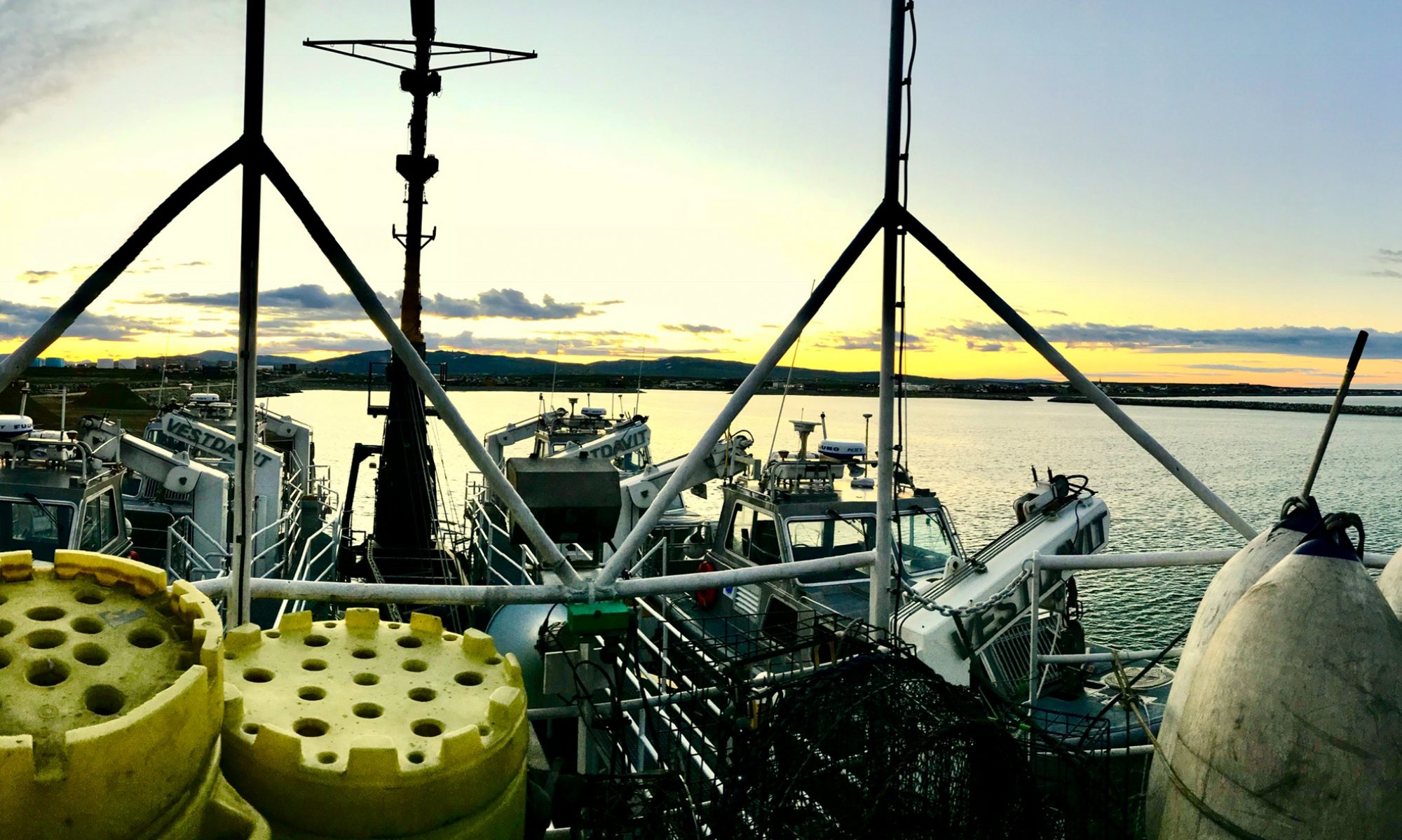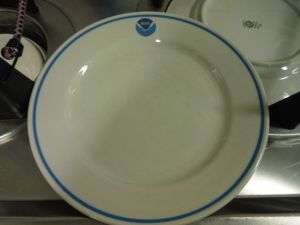NOAA Teacher at Sea Virginia Warren
Mission: Acoustic and Trawl Survey of Walleye Pollock
Geographical Area of Cruise: Shelikof Strait
on NOAA ship Oscar Dyson
Date: 3/25/2016
Science and Technology Log:
I created the video below to document some of my activities aboard the Oscar Dyson during my 2016 Teacher at Sea research trip.
In this video, Virginia opens with exciting footage from the front of the Oscar Dyson’s bow as they transit through Alaska’s Shelikof Strait. Interspersed, she shares various steps involved in processing the fish caught in the survey: sorting the catch by species (0:34), collecting the pollock into bins (1:00), making an incision to determine the sex of the pollock (1:07), measuring the pollocks’ lengths and taking biological samples (1:33), removing the otoliths (2:23 and 3:29), preserving the otoliths for analyzing on shore (3:12), and measuring and recording other fish using the Ichthystick and the CLAMS computer program (3:57). Virginia also takes the opportunity to show off some interesting species—lumpsucker fish (2:18), starry flounder (2:53), and salmon (3:53). Finally, Virginia gives a brief tour of the deck (4:38) and finishes with a photo of her wearing a survival (or “Gumby”) suit (5:02.)
My students know a good bit about my previous Teacher at Sea experience out of Woods Hole, Massachusetts where we used the HabCam to look at the ocean floor. With that knowledge in mind a couple of my students asked me if there was a way that we were able to look at the fish while they were still in the water. The simple answer to that question is yes. While my previous TAS experience used the HabCam, the Oscar Dyson uses a CamTrawl. The CamTrawl is attached to the net and it records pictures as fish enter the cod end of the net.



After each trawl we would use custom software written in MATLAB to measure lengths of pollock while they were in the water. This program uses the pictures taken from the CamTrawl during the trawl to measure the length of the fish. The CamTrawl takes two pictures at different angles so that most of the time we can see the same fish from two different angles. Fish length irregularities occur in the MATLAB program when it selects nets or two fish at one time to length, so therefore a person has to go back and check to make sure that the program has selected valid fish to length. As the fish pictures come up on the MATLAB screen the person rating the fish selects the fish when the yellow box around the fish covers most of the fish from both angle camera shots of the CamTrawl.

The above picture shows three different fish that were valid choices for length measurement. The pictures on the left show one camera angle and the pictures on the right show the other camera angle. When both angles have a valid fish with the correct placement of the yellow box, the person selecting the fish will click the fish to tell the program to use that fish in the measurement data.
Interview With a NOAA Survey Technician: Alyssa Pourmonir

- How did you come to be in NOAA Corps? (or what made you decide to join NOAA Corps and not another military branch.
I am not in the NOAA Corps, instead I am a civilian government employee under the title of Survey Technician. I was in the US Coast Guard for 3 years where I took many courses related to navigation, leadership, and ship life. I feel my background in the Coast Guard has allowed me to excel in this demanding environment.
- What is your educational/working background?
I have been lucky to have the opportunity to be in the Coast Guard which taught me many professional skills and built me up to be stronger and more independent. I also spent an entire summer forecasting for the weather in Pennsylvania. Here I gained an abundance of practice presenting the weather on the green screen and performing on live television for WNEP TV. Before coming to Alaska for this job, I worked as a consultant at NASA Stennis Space Center performing remote sensing analysis of forests using data from the MODIS and VIIRS data.
Academically, I have a BS in Marine Environmental Science from SUNY Maritime College, although most of my college experience took place at the US Coast Guard Academy.
- How long have you been in NOAA Corps?
I’m not in the NOAA Corps, but I have worked for NOAA for almost 2 years as a Survey Technician. May 2014 to present.
- How long have you been on the Dyson?
June 2014 to present.
- How long do you usually stay onboard the ship before going home?
In the past 2 years I have visited my family one time. Partly because I wish to send money home so my family can struggle a little less and hopefully enjoy a life with less debt; especially as my father passes retirement age. He has worked several full time jobs at a time for many years just to support my mom and sisters. Potentially, his work ethic and care giving nature is what I try to embody each day.
- Have you worked on any other NOAA ships? If so, which one and how long did you work on it?
Nope
- What is your job description on the Dyson?
On the NOAA Oscar Dyson, I am a crew member who acts as a liaison to the scientific personnel on board. I work up to 12 hours each day, 7 days per week maintaining the scientific data, equipment, and lab spaces on board. I also work alongside the scientists, deck department, and bridge watch standers to collect data by completing many different oceanographic or fishing operations.
- How is your science job on the Dyson different from the NOAA Scientists that you work with?
As a crew member, I facilitate a positive environment with the needed resources for the scientists to fulfill their data analysis and data collection. I also work alongside the scientists to process the fishing catch in our lab. So you can imagine me suited up with the scientists analyzing the fish’s reproduction development stages and extracting otoliths.
- What is the best part of your job?
I get to explore and work in the infamous Bering Sea Alaska, Gulf of Alaska, and Aleutian Island chain which most people can’t even imagine doing. Here in Alaska, I do not have the luxuries found in Continental US, so I believe out here there is a great opportunity for character building. It takes someone pretty amazing to live out here and do what we do.
- What is the most difficult part of your job?
Being in remote places and not seeing family or friends, but also being so far away that it is super expensive to try to see them.
- Do you have any career highlights or something that stands out in your mind that is exceptionally interesting?
I began my BS absolutely hating biology. I dislike and do not eat seafood. I was skittish and would let my partners do all of the dissections during classes, and I felt that I knew nothing about biology. As a Marine Environmental Science major I decided to take as many biology electives as I could. I went from the lowest grade in my classes to someone who received one of the highest grades in each class. I graduated just one class shy of a minor in Marine Biology and now toss around fish on the NOAA Ship Oscar Dyson, a fisheries research vessel. While my first day I would jump when the fish would move unexpectedly, now I can analyze characteristics of the fish with little alarm and much confidence. It is amazing how I enjoy biology now. I hope to encourage others to confidently try new things, for with a little practice and hard work you may accomplish anything or overcome fears you may not have realized you had.
- Do you have any advice for students who want to pursue a career with NOAA?
If you wish to pursue a career with NOAA, be sure to work hard to learn as much as you can, but also come out of your comfort zone to pursue as many volunteer or paid jobs that will give you work experience that correlates with your interests. Time management and resilience is often my secret to success.
Personal Log:
I had a fabulous time aboard NOAA Ship Oscar Dyson and I’m very thankful to NOAA giving me the opportunity to travel to Alaska and learn from their scientists!!!
My flight home started on a small plane from Kodiak to Anchorage.

After the plane got into the air and was flying away from Kodiak, we were treated to a flyby of the Kodak Harbor and even got to see the Dyson outside of the harbor as we flew away.

We flew into Anchorage, Alaska and I was amazed at the beauty of the mountains in Alaska!

A little while before sunset I caught a plane from Anchorage to the Chicago, O’Hare airport. The scenery and sunset leaving Alaska was beautiful!!!! I hope this won’t be the last time I get to come to Alaska, because it is a beautiful, adventure-filled part of the United States.
It was good to be back on land again when we got back to Kodiak, but I do miss being on the ocean!!



This experience was wonderful for me, however for my students this experience was invaluable. I was able to communicate and share my experiences with them through email almost daily and they were also able to read my TAS blogs as they were posted. If they don’t learn anything else from my experiences in Alaska, which I know that they will, I hope they will learn that the world is theirs to explore, study, and learn about no matter how small the town is that they come from!!
















































































